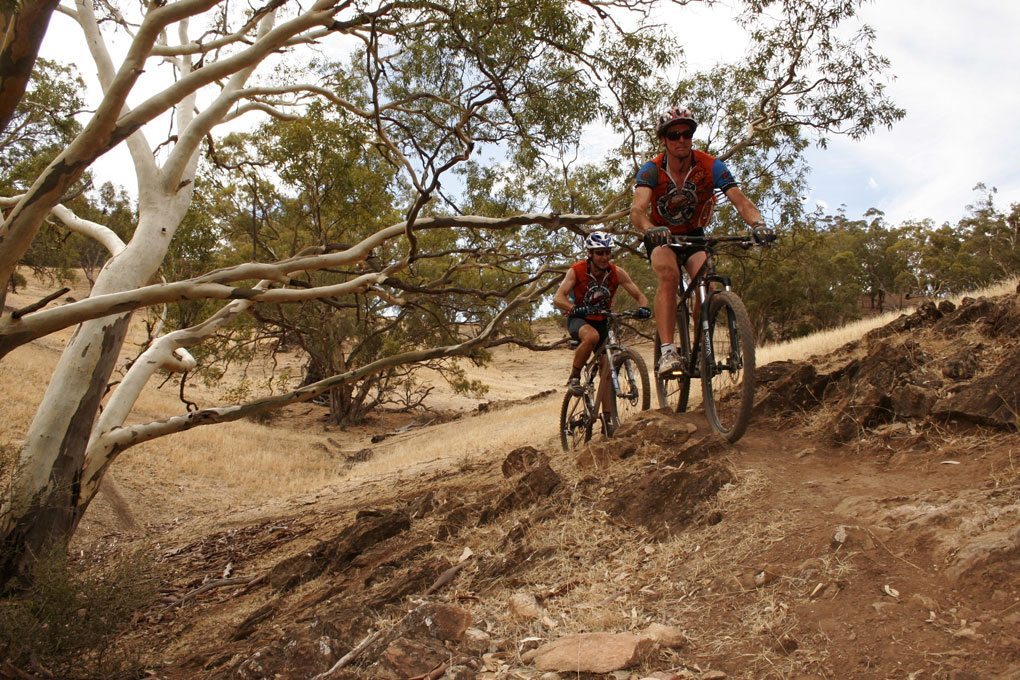11) BLISTER: How would you define “Over the Edge” today?
Troy: Over the Edge Sports is a “group.” We’re less and less accurately described as a bike shop. But what makes it different is that Over the Edge is involved in all these pieces. All Over the Edge owners are involved in trail building and working to get it put together. All are individually owned and run by locals. Our group has some really good relationships and has pioneered how to be better as a team than as solo shops.
12) BLISTER: In September of 2010, You transferred ownership of Over the Edge Fruita to George Gatseos and Ross Schnell. Why the change, and why those guys?
Troy: I was still at the helm of the Fruita store when we also had stores in Hurricane and Melrose, both of which opened in 2007, and I was getting pushed in different directions. My departure from being the “owner” at OTE Fruita was essential to my ability to focus on the vision of all the stores as a group, and in my role of helping them each with their specific success and key issues. Ross was our little sponsored racer at 13-14 years old, but George has been running the Fat Tire Festival in Fruita for over a decade. I originally met him in ‘95 when he came over on his rigid Cannondale aluminum bike and we proceeded to beat the crap out of him on these rough Fruita trails. But I am extremely grateful that George is running things every day in Fruita and making that shop rock.
13) BLISTER: So how would you describe your role today?
Troy: I’d say I’m a “Mountain Bike Tourism Consultant.” I have this wealth of experience with all the things we did right and the things I would do differently, and it all adds up to my newest “job.” People want to hear the story of how it happened in Fruita. They want to mimic the Fruita model, and who better to talk about it than someone who lived it and learned those lessons firsthand? I love sharing the Fruita story and have found that I can really help other mountain bike communities with the things I have seen in my life.
14) BLISTER: And that’s what happened in Melrose, Australia?
Troy: When I first went over to Melrose I was working for South Australia Tourism, and we looked at a bunch of towns. As people are looking for ways to reinvigorate their towns, mountain biking has become a noted piece of the economic puzzle. Melrose seemed like the best place. You’re just south of a mountain there and beyond that is the outback, where you get views of the outback, you get views of that country. You can also see the ocean. The farthest you ever are from a trailhead is, like, a block. But in Australia, technical riding isn’t the standard. I hear people complain about it. We meant the trails to be at the cutting edge of what’s going on in Australia.

15) BLISTER: What other places have you looked at?
Troy: After this year’s Fat Tyre Festival in Melrose, I went out to western Australia and spoke out at a mountain bike conference at a town called Collie. Collie has an awesome, unique landscape with like 300-foot-tall trees and this soil that’s rich with iron. And I’m talking to a guy that’s been pioneering a singletrack route from Geneva, Switzerland, to Nice, France, all the way through the Maritime Alps. Apparently it’s stuff that has existed and it’s just piecing this route together. He claims he’s got about 100,000 feet of descending in that week-long route from Geneva to the ocean.

Great article. Mining waste turned into a “new” type of gold. Lots of land in the West and also places like Pennsylvania and West Virginia in the East that can benefit from this type of creative re-use.
It’s certainly true, and the Ghost Town Trail from Blacklick to Ebensburg in Pennsylvania is a good example of a trail having been built in one of these places. Although the GTT is relatively flat and follows the creek (i.e. it’s not as varied or technical as Troy describes Fruita to be), it definitely counts as “creative” re-use—you ride past abandoned mining towns and leftover train cars along its 36 miles. Very cool.
Some tough questions were omitted/ignored here. Anyone who watched what Troy & Sarah did in Fruita knows about the many headaches surrounding over-use of trails that went from fun narrow singletrack to trampled crypto soils and 4 foot wide pathways, and how it became difficult to stop the trail dummying thanks to “promoting” the town as a MTB destination. Not everyone wants crowded trails, not everyone can manage trail over-use with constant maintenance/upkeep. Do the people of Fruita like what their town has become? Did any of them leave the town due to its shift in character?
There’s an unquestioned assumption here: that building a MTB “destination” town is great for everyone.
I’d be interested in alternate views on that subject. Who did NOT like it? Who thinks the town wasn’t improved by the changes? Who finds the trail maintenance a headache? Who prefers the old Fruita trails that were narrow and challenging due to narrowness?
Go back in time to read Troy’s rants on the OTE website/blog. You’ll see what I’m talking about here.
Congrats for sure to Troy & Sarah and the OTE crew for the trails they built and the FFTF they created, it is a fun place to ride MTBs.
But there’s more to the story.
@ Pup Tentacle, who pissed in your Cheerios this morning?